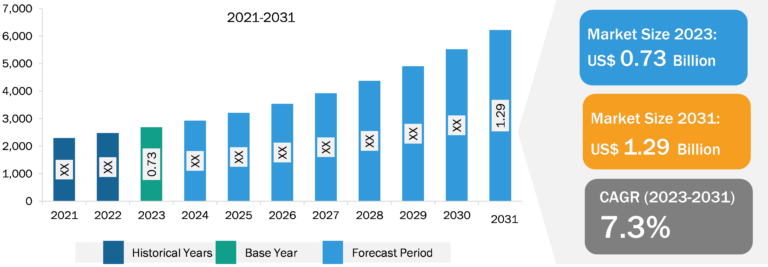
Automotive Fabric Market
In 2022, Asia Pacific dominated the global automotive fabric market. The market growth in Asia Pacific is driven by the strong presence of the automotive industry. Asia Pacific is a hub for automotive manufacturing with a large presence of international and domestic players operating in the region. According to a report published by the China Passenger Car Association, Tesla Inc delivered 83,135 made-in-China electric vehicles in 2022, indicating growth in sales of electric vehicles compared to 2021. The International Organization of Motor Vehicle Manufacturers report states that various countries in Asia Pacific produced ~46.73 million units of motor vehicles in 2021.
The government of China aims to raise the cumulative production capacity of automobile manufacturers in the country to 35 million units by 2025. According to the 2022 report by the International Energy Agency, China recorded electric vehicle sales of 3.3 million in 2021. Automotive carpet is effectively designed to keep the vehicle’s floor free from dirt, wear, and corrosion from salt, thereby maintaining cleanliness. Automotive fabric is used in cargo areas of SUVs, minivans, and hatchbacks, providing a clean appearance and protection to cargo. A few forms of automotive fabric are designed for soundproofing and noise reduction in the vehicle. Thus, the growing automotive industry in Asia Pacific is expected to create lucrative business opportunities for the automotive fabric market players in the region during the forecast period.

Rising Focus on Automotive Aesthetics and Interior Quality
The focus on developing automotive interior and exterior aesthetics and properties has increased, owing to consumer emphasis on quality and aesthetics, which drives the demand for automotive fabrics. Governments of various countries imposed stringent safety regulations, including the mandatory installation and use of seat belts, airbags, and anti-lock braking systems to promote in-vehicle safety, which is boosting the demand for high-performing and safe automotive fabric materials.
Automotive fabric is used extensively in car interiors for seats, door panels, and headliners. The choice of fabric significantly impacts the interior design, offering a wide range of colors, textures, and patterns to match the desired aesthetic. Automotive fabric enhances the overall perception of a vehicle and creates a look of luxury for passengers. Advancements in fabric technology have led to innovative features such as stain resistance, climate control, and smart textiles, which can enhance the aesthetic and functionality of car interiors. Automotive manufacturers utilize specific fabrics and color schemes to establish brand identity and consistency across their product lines, making the car instantly recognizable to consumers. Thus, the rising focus on automotive aesthetics and interior quality fuels the automotive fabric market growth.
Automotive Fabric Market: Segmental Overview
Based on component, the automotive fabric market is segmented into carpet, headliner, hood liner, insulation, seat covering material, and others. In 2022, the carpet segment held the largest market share; it is expected to record the highest CAGR from 2022 to 2030. Automotive carpet is effectively designed to keep the vehicle’s floor free from dirt, wear, and corrosion from salt, thereby maintaining cleanliness. Fabrics for carpets are exclusively designed with a needle-punched, nonwoven, or tufted fabric. Polyester, polyamide, polypropylene, and aramid are preferably used as fiber materials in designing carpets to enhance automotive interiors.
Based on material, the automotive fabric market is segmented into textiles, artificial leather, genuine leather, and artificial suede. The textiles segment held the largest automotive fabric market share in 2022. Automotive textiles have several applications in cars, trains, buses, and other vehicles. Automotive textiles comprise different types of textile components such as yarn fibers, filaments, and other fabrics. These textiles are an essential aspect of technical textiles and are extensively used in in-vehicle components to promote aesthetics and ensure safety and quality. Textile materials are required for various components, including coverings for seating areas, headliners, side panels, carpets and trunks, and airbags. Besides the interior trim components, these textiles are also ideal for reinforcing tires, hoses, and safety belts.
Impact of COVID-19 Pandemic on Automotive Fabric Market
Before the COVID-19 pandemic, many countries reported economic growth, whereas automotive fabric manufacturers invested in research to develop advanced technology and improve production efficiency. The chemical & materials industry announced a slowdown of manufacturing operations and shutdown, as well as projected a slump in automotive fabric sales. Thus, major companies involved in automotive fabric production were severely affected during the initial phase of the pandemic due to sudden government restrictions on the manufacturing of nonessential commodities. In 2021, several automotive companies began recovering from the losses incurred in 2020 with the revival of production operations. Manufacturers were permitted to operate at full capacities, which helped them cope with the demand-supply gap. With economies reviving their operations, the demand for automotive fabric started rising globally as the automotive industry resumed its operations at full capacity.
Automotive Fabric Market: Competitive Landscape and Key Developments
Lear Corp, Bader GmbH & Co KG, BOXMARK Leather GmbH & Co KG, AUNDE Group SE, Grupo Empresarial Copo SA, Classic Soft Trim Inc, Dual Borgstena Textile Portugal Unipessoal Lda, Shawmut Corp; Apex Mills Corp, Seiren Co Ltd are a few players operating in the global automotive fabric market. Players operating in the global automotive fabric market focus on providing high-quality products to fulfill customer demand.
Key Developments
- In September 2023, Apex Mills acquired the HanesBrands Inc. facility in Stuart, the US. The acquisition has helped in the expansion of elastomeric knitting, dyeing, and finishing capabilities.
- In March 2022, Lear Corp completed the acquisition of Thagora Technology SRL, a Roman company. The acquisition helped Lear Corp to add scalable smart manufacturing technology to its competencies.
- In May 2021, JBS Couros SA launched antiviral leather with V-Block technology. The company is a supplier to furniture, automotive, footwear, and leather goods markets.







